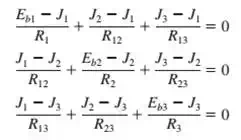RADIATION HEAT TRANSFER: DIFFUSE, GRAY SURFACES
1) The analysis of radiation transfer in enclosures consisting of black surfaces is relatively easy but most enclosures encountered in practice involve nonblack surfaces, which allow multiple reflections to occur
a) Radiation analysis of such enclosures becomes very complicated unless some simplifying assumptions are made. It is common to assume the surfaces of an enclosure to be opaque, diffuse, and gray
b) Before proceeding further we have look into Radiosity in detail
i) Surfaces emit radiation as well as reflect it, and thus the radiation leaving a surface consists of emitted and reflected parts.
ii) The total radiation energy leaving a surface per unit time and per unit area is the radiosity and is denoted by J
For a surface i that
is gray and opaque  the radiosity can be
expressed as
the radiosity can be
expressed as



iii) For black body  the radiosity of a blackbody is
equal to its emissive power
the radiosity of a blackbody is
equal to its emissive power
c) Net Radiation Heat Transfer to or from a Surface
i) 



ii) 

Applying
the reciprocity relation 



iii) 

iv)  Radiation Heat Transfer in Three-Surface
Enclosures
Radiation Heat Transfer in Three-Surface
Enclosures
 The algebraic sum of
the currents (net radiation heat transfer) at each node must equal zero
The algebraic sum of
the currents (net radiation heat transfer) at each node must equal zero
